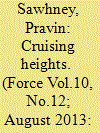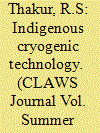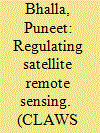| Srl | Item |
| 1 |
ID:
126378


|
|
|
|
|
| Publication |
2012.
|
| Summary/Abstract |
Two news items regarding the DRDO long-range cruise missile mission need to be flagged. First, in a rare admission by a DRDO chief, M. Natarajan, days before his retirement on 1 September 2009, said that, "The lack of success in developing indigenous propulsion systems for the country's major programmes is a cause of concern. Affected are programmes such as the aero engines for fighter aircraft and unmanned aerial vehicles, engines for tanks and naval propulsion and ramjet and hypersonic propulsion for missiles."
|
|
|
|
|
|
|
|
|
|
|
|
|
|
|
|
| 2 |
ID:
131027


|
|
|
|
|
| Publication |
2014.
|
| Summary/Abstract |
From launching sounding rockets on the Kerala coast in the 19605, to the launch of ten satellites in one go in April 2008, Indian space scientists have indeed come a long way. In fact, this January, taking one more crucial step in space technology has further strengthened their resolve to accomplish other space-related goals. After two decades of the protracted and focussed research and developmental efforts of the Indian Space Research Organisation (ISRO) scientists, it was India's turn to celebrate the glory of its space programme on January 05, 2014, when ISRO's Geosynchronous Satellite Launch Vehicle (GSLV-D5), powered by an indigenously developed cryogenic engine, successfully launched the GSAT- 14, a communication satellite, from Sriharikota
|
|
|
|
|
|
|
|
|
|
|
|
|
|
|
|
| 3 |
ID:
131028


|
|
|
|
|
| Publication |
2014.
|
| Summary/Abstract |
The freedom of operations in space and of remote sensing by satellites has been globally accepted through different UN Conventions. Satellite imaging provides unrestricted access to areas transcending international borders and its commercialisation has resulted in the irrelevance of these borders even for distribution of data as commercial entities seek a larger and more diversi?ed customer base. Availability of such information commercially is enabling and in?uencing worldwide scienti?c, technological, social and economic advancements. However, its dual use potential that could provide disproportionate strategic and military advantages has raised concerns regarding the distribution. Differing interests have made regulating the sector a complex task. Nations that possess the capability want to strike a balance between their national security interests and foreign policy concerns, on the one hand, and commercial interests, on the other. At the same time, all nations remain apprehensive about the distribution of information about their area without their knowledge or consent.
|
|
|
|
|
|
|
|
|
|
|
|
|
|
|
|